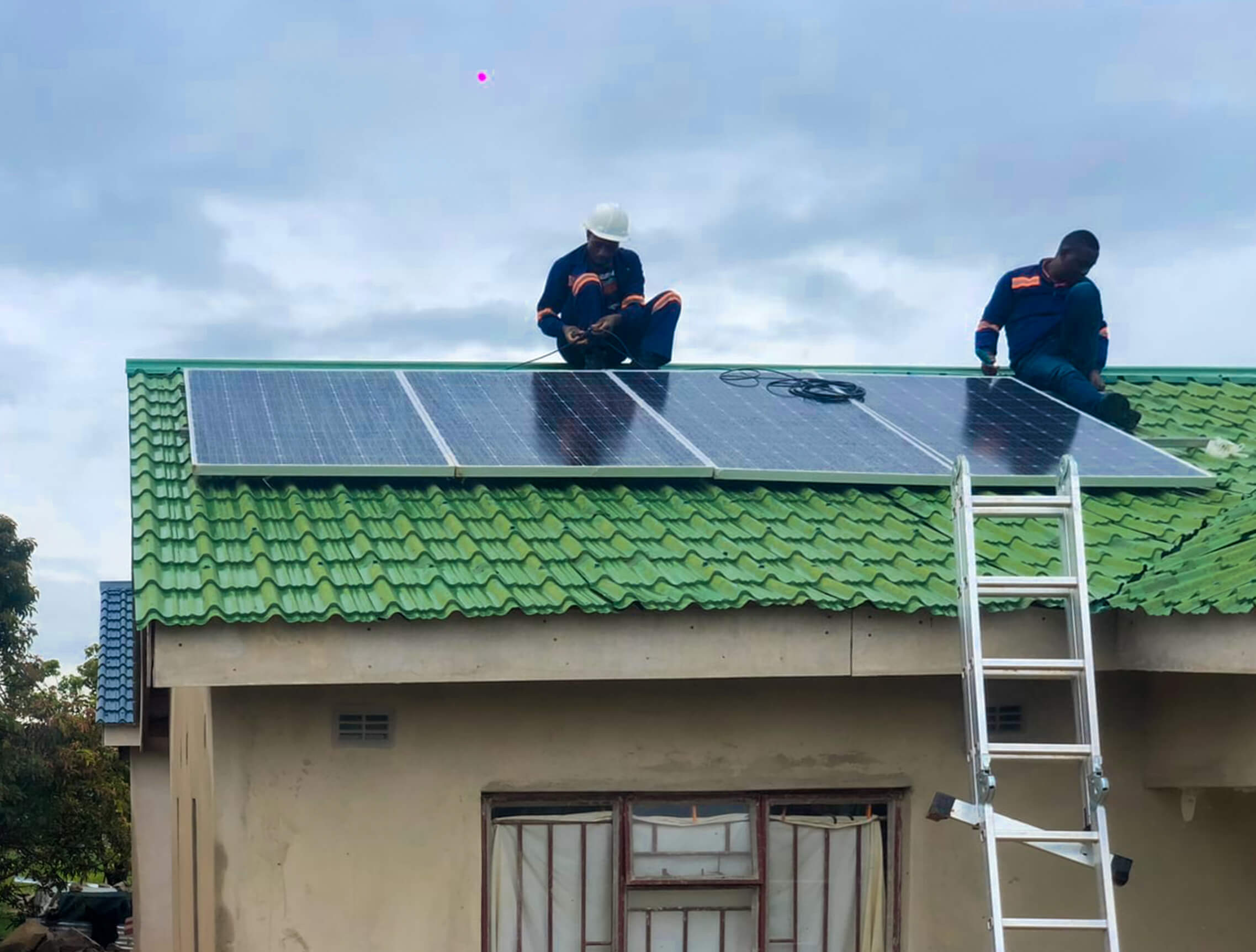By Bonface Orucho
More Africans are spending less on accessing electricity than before, largely thanks to the accelerating shift toward renewable energy.
According to experts, the cost of generating and distributing energy is falling, and this is gradually translating to more affordable tariffs, especially in off-grid and rural areas.
“What we’re seeing is the cumulative effect of years of investment in renewables and policy innovation across the world,” Abraham Masiyiwa, a researcher at the Power Energy Futures Lab explained in a call.
“From mini-grids to utility-scale solar, the continent is not just adopting clean energy it’s actively shaping how affordable electricity is delivered in low-income contexts,” he added.
A July 2025 report by the International Renewable Energy Agency (IRENA) has confirmed the trend, showing that 91% of new renewable energy projects globally are now cheaper than fossil fuel-based alternatives.
According to the IRENA report, in 2024, solar photovoltaics were, on average, 41% cheaper than the lowest-cost fossil fuel alternatives, while onshore wind was 53% cheaper. This price advantage is driven by innovation, stronger supply chains, and economies of scale.
This is a major development for the continent, where high energy costs have long excluded millions from the grid. As renewable technologies become more affordable and widespread, electricity is reaching more homes and businesses at a lower cost per unit than ever before.
In 2024, the global weighted average cost of new onshore wind power dropped to just US$0.034 per kilowatt-hour, while solar PV reached US$0.043 per kilowatt-hour. These prices undercut even the cheapest fossil fuel options and highlight why renewables are now considered the most cost-competitive form of new power globally.
Utility-scale solar PV installations in Africa have mirrored this trend, with average installed costs dropping by 68% over the last decade, from US$ 3 437 per kilowatt in 2015 to US$ 1 093 in 2024, according to IRENA.
Over the same period, Africa’s average solar electricity cost fell from US$ 0.225 to just US$ 0.074 per kilowatt-hour, approaching parity with global markets.
Africa is home to some of the world’s richest solar and wind resources. IRENA notes that regions like Africa, Asia, and South America have strong learning rates and untapped renewable potential, meaning costs could fall even further in the coming years.
Onshore wind projects across the continent have also seen their levelized costs of electricity decline by 34% since 2010, dropping to US$0.051 per kilowatt-hour in 2024.
However, according to Masiyiwa, “financing, not equipment, is the largest cost component,” reflecting the persistent capital-market challenges facing African developers.
The result is a shift in how electricity is accessed and paid for. In Kenya, South Africa, Morocco, and Egypt, large-scale renewable projects have become the dominant new sources of generation.
This helps reduce reliance on costly fuel imports and enables more stable, predictable pricing.
In Nigeria and other countries, rural communities that once relied on diesel generators or kerosene lamps are now turning to solar mini-grids and solar home systems.
“These decentralized systems often provide power at a fraction of the previous cost, and with greater reliability.”
Access to off-grid solar in Africa is surging. In 2024 alone, GOGLA (Global Off-Grid Lighting Association) affiliates sold 9.3 million solar kits and nearly 2 million appliances like fans, fridges, and water pumps, serving over 137 million people.
In Nigeria alone, nearly 120 solar mini-grids have been installed in recent years, powering tens of thousands of households. Developers say these grids can cut the cost of electricity by up to 60% compared to diesel generators, while also enabling businesses to operate more efficiently.
Even in more infrastructure-intensive systems like small hydropower, Africa is starting to benefit from global learning curves. Though average installation costs remain high at over US$ 4 000 per kilowatt, the highest globally costs are declining. Between 2010–17 and 2018–24, levelized hydropower costs in Africa fell significantly, thanks to efficiency gains in construction and equipment sourcing .
The economic impact of this shift is already visible. Families are saving money, small shops can stay open longer, and students have more hours of light to study. In agriculture, solar irrigation and cold storage are beginning to improve productivity and reduce post-harvest losses.
According to AFSIA, replacing kerosene with solar lighting can save typical African households more than 70% on lighting bills. For many, this frees up income for essentials like food, school fees, or savings.
These shifts also contribute to macroeconomic gains. Modeling by IRENA and the African Development Bank suggests that a full-scale transition to renewable energy could boost Africa’s GDP by 6.4%.
Still, financing remains the thorniest constraint. Even as costs of equipment plummet, the average cost of capital for African renewable projects remains at around 12%.
This is three times higher than Europe.
“This imbalance means African developers pay more for the same projects, pushing tariffs higher despite falling hardware costs,” IRENA explains in the report.
Importantly, according to Masiyiwa, the falling cost of electricity is not only a byproduct of cheaper hardware.
“Policy reforms, public-private partnerships, and targeted subsidies have also played a role… In countries like Rwanda and Ethiopia, streamlined licensing and results-based financing have helped scale solar solutions quickly and at lower cost.”
Grid integration also poses a growing constraint. Wind and solar projects in emerging markets often face delays due to limited transmission capacity, slow permitting, and high local supply chain costs. In some African countries, grid infrastructure is too weak to absorb new renewable inputs without significant investment.
Even with rapidly falling costs, many African households still need financial support to afford solar systems or pay monthly mini-grid tariffs.
According to Masiyiwa, “the poorest communities, especially in fragile states, risk being left behind without concessional financing or subsidies.”
However, beyond generation, technological improvements are also reshaping the cost dynamics.
Battery energy storage system (BESS) prices have fallen by 93% since 2010, reaching US$192/kWh in 2024, according to IRENA.
This makes it cheaper to store solar and wind power for evening use or backup, especially in off-grid areas. Hybrid systems that combine solar, wind, batteries, and digital tools are also increasingly being deployed to improve energy reliability.
Earlier, in June 2025, for instance, Africa’s largest standalone battery energy storage project, Red Sands BESS, reached commercial close in South Africa.
The 153 MW facility is expected to ease grid congestion, store solar energy, and boost reliability across the Northern Cape’s renewable-heavy supply area.
bird story agency
Accelerating adoption of renewable energy in Africa is leading to reduced electricity costs, enhancing access, particularly in off-grid and rural areas.
Falling costs of energy generation are attributed to global investments and innovations, with 91% of new renewable projects being cheaper than fossil fuel alternatives.
Solar photovoltaics and onshore wind are notably less expensive, and Africa's vast renewable resources present opportunities for further cost reductions. In countries like Kenya, South Africa, Morocco, and Egypt, large-scale renewable projects are reducing dependence on costly fuel imports, while rural communities are shifting to more affordable solar mini-grids.
Despite progress, financing remains a major challenge, with high capital costs for African projects keeping electricity prices elevated.
Efforts involving policy reforms, public-private partnerships, and subsidies have supported growth in renewable technologies.
Battery storage advancements are reducing costs and improving energy reliability, while Africa's largest standalone battery project, Red Sands BESS in South Africa, is set to enhance grid efficiency.
The transition to renewables is expected to boost Africa's GDP, though continued financial support is necessary to ensure equitable access to renewable energy across the continent.






